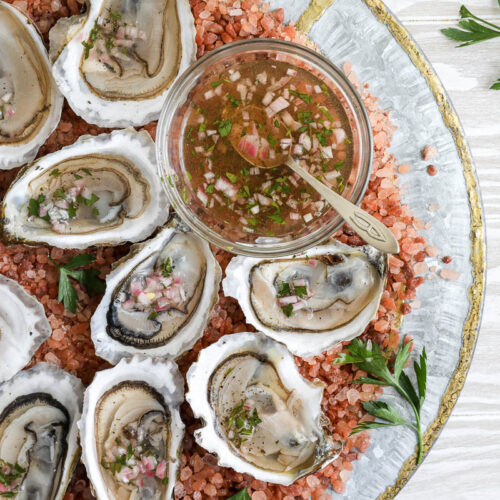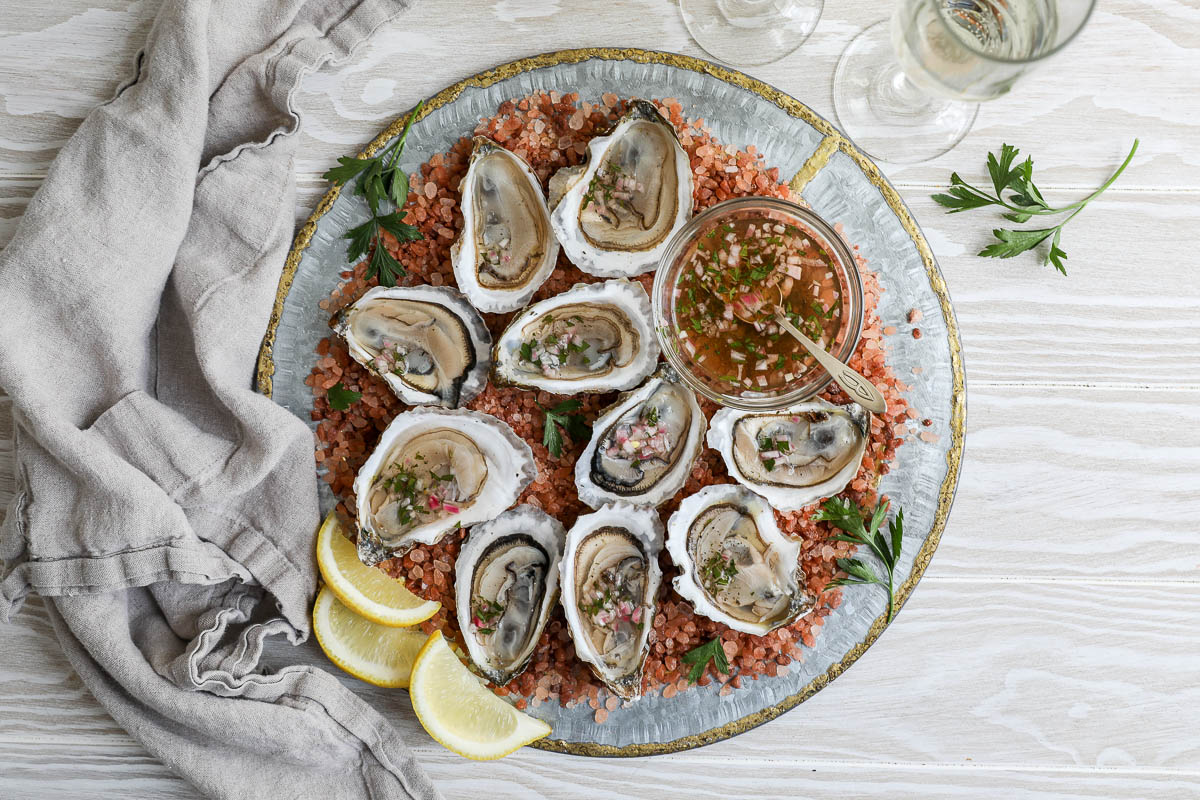Oysters on the Half Shell.
Oysters with a champagne mignonette made with white wine vinegar, champagne, shallot, parsley and black pepper.

What are oysters on the half shell?
Oysters are on the half shell are raw oysters that have been shucked (pried) open. The top shell has been removed and the muscle (edible portion) has been severed from the bottom shell, ready for slurping. So, it’s an oyster sitting in half of its shell (the bottom cup-shaped shell). Oysters on the half shell are typically served chilled and overtop crushed ice.
What kind of oysters should you use?
Any kind you like! Nowadays, we all have access to fresh oysters regardless of where you live (near the sea or landlocked) because of refrigerated overnight shipping. We live on Cape Cod where we have access to dozens of varieties of oysters (Wellfleet oysters probably being our favorite), each taking on their own merroir. Merroir (like terroir for wine) means that each oyster tastes like its surroundings – what it eats, the water it lives in, the temperature, the tides, the mineral content and more. Basically, an oyster and its flavor profile is a product of its environment.
The most important thing about purchasing oysters is freshness. Know and trust your fishmonger and where he/she is getting the oysters. Make sure they are stored properly (on ice but NOT in water) and use proper food safety practices when shucking and serving them. And, if an oyster doesn’t look right or smell right to you, throw it out. (That saying “when in doubt, throw it out” applies here.)

How do you store oysters?
According to Island Creek Oysters, keep them cold and dry in the fridge. If they came in a mesh bag, you can store them in that in a bowl with a damp cloth over them. Or store them in a bowl or on a baking sheet (cup side down) covered in a damp towel.
When serving them, serve them on top of ice, but don’t store them on or under ice because fresh water kills them. When you purchase the oysters, find out when they were harvested and how long you can store them. When we purchase oysters, I use them that day – possibly the next day. Some say if they were just harvested you can store them properly and use in a week or up to 2, but I’m not comfortable with that timeline.

What should you serve oysters with?
We love oysters with lemon wedges and a mignonette. A mignonette sounds fancy, but it’s not. Typical mignonettes combine vinegar, shallots and black pepper. This champagne mignonette combines white wine vinegar, a splash of champagne (getting a tad bit fancy here!), shallot, parsley and black pepper. But, serve oysters with whatever and however you like. A good rule of thumb is you don’t want the accompaniments to overwhelm the subtle flavor of the oysters.
Aside from mignonettes, oysters are also often served with:
- cocktail sauce
- horseradish
- hot sauce
- pesto (we live raw and grilled oysters with just a dab of pesto)

How do you shuck oysters?
Oyster shucking can be intimidating, but after a little bit of practice you can be on your way to becoming an oyster shucking expert (or at least an amateur). Don’t expect to get it on your first (or 10th try). But, believe me, the skill will come.
Here’s a quick video on how to shuck an oyster if you’re a visual person like me.
And here are the steps to shuck an oyster:
- Prepare a tray with crushed ice and any oyster accompaniments
- Discard any broken or cracked oysters
- Scrub your oysters with a firm brush – I use a vegetable brush – to remove grit, dirt and debris from the oyster
- You’ll want to wear a protective glove on your non-knife yielding hand to protect your hand from the shucking knife. Alternatively, use a kitchen towel for protection, but sometimes this doesn’t offer all the protection needed
- Place your oyster on a flat working surface or place into your non-dominant glove protected hand. If placing the oyster on a flat surface, hold it still with your non-dominant hand
- Insert your oyster shucking knife into the hinge of the oyster and gently rock your knife back and forth until you hear and feel a pop
- Wipe your knife clean of any gunk that was in the hinge
- Keep the oyster steady, as you don’t want to spill the liquor (oyster juice)
- Slide the knife right underneathe the top shell and over top the oyster muscle, to remove the top shell; discard the top shell
- Slide your knife underneath the oyster muscle to sever the muscle from the bottom shell
- Place the shucked oyster onto the tray with ice
- Repeat for all of your oysters
What are the health benefits of oysters?
Oysters are loaded with nutrition. They are especially rich in protein, Vitamin D, selenium, Vitamin B12, iron, zinc, copper, selenium and contain many more vitamins and minerals. Oysters also contain anti-inflammatory and brain and heart health promoting omega-3 fatty acids.
Children and those who are pregnant, breastfeeding or those with weakened immune systems should not eat raw oysters, but can safely eat cooked oysters.

Here’s how to make these oysters on the half shell with champagne mignonette:

Oysters on the Half Shell
Ingredients
- 12 oysters shucked
- 2 tablespoons white wine vinegar
- 2 tablespoons Champagne, Prosecco or Cava dry
- 1 tablespoon shallot minced
- 1 teaspoon parsley fresh and chopped
- 1/4 teaspoon black pepper freshly ground
For serving
- 1 lemon cut into wedges
Instructions
- Place shucked oysters over ice or rock salt on a chilled platter.
- Combine vinegar, sparkling wine, shallot, parsley and black pepper in a small bowl.
- Serve with lemon wedges and bubbly (for drinking).
Nutrition
PIN this oysters on the half shell recipe for later:

Looking for more oyster recipes?
- Try these Grilled Oysters with Garlic Butter


Leave a Comment